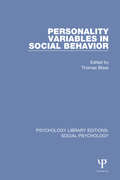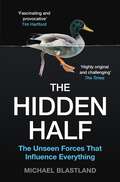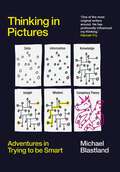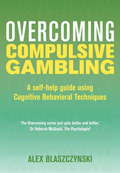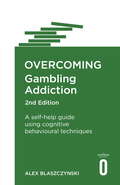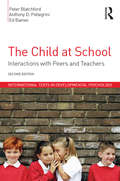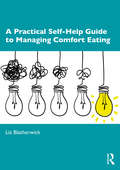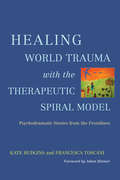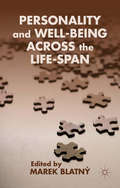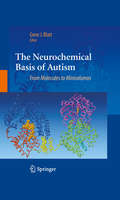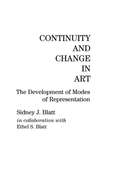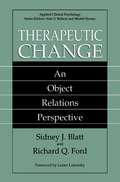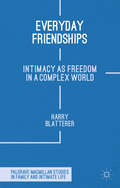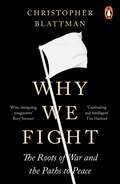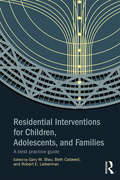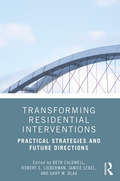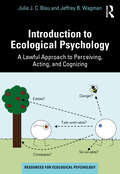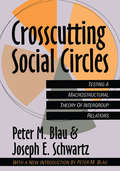- Table View
- List View
Personality Variables in Social Behavior (Psychology Library Editions: Social Psychology)
by Thomas BlassOriginally published in 1977, the aim of this volume was to demonstrate in a concrete way the relevance of some of the most important individual variables for various domains of social behaviour. Eminent researchers at the time contributed original chapters that provided an up-to-date perspective on theory and research on important and widely used personality constructs. This volume should serve as a text for advanced level students seeking a historical introduction to specific personality variables and a survey of theory and research on the most widely used personality dimensions of the time.
Personality Variables in Social Behavior (Psychology Library Editions: Social Psychology)
by Thomas BlassOriginally published in 1977, the aim of this volume was to demonstrate in a concrete way the relevance of some of the most important individual variables for various domains of social behaviour. Eminent researchers at the time contributed original chapters that provided an up-to-date perspective on theory and research on important and widely used personality constructs. This volume should serve as a text for advanced level students seeking a historical introduction to specific personality variables and a survey of theory and research on the most widely used personality dimensions of the time.
The Hidden Half: How the World Conceals its Secrets
by Michael BlastlandWhy does one smoker die of lung cancer but another live to 100? The answer is 'The Hidden Half' - those random, unknowable variables that mess up our attempts to comprehend the world.We humans are very clever creatures - but we're idiots about how clever we really are. In this entertaining and ingenious book, Blastland reveals how in our quest to make the world more understandable, we lose sight of how unexplainable it often is. The result - from GDP figures to medicine - is that experts know a lot less than they think. Filled with compelling stories from economics, genetics, business, and science, The Hidden Half is a warning that an explanation which works in one arena may not work in another. Entertaining and provocative, it will change how you view the world.
Thinking in Pictures: A Sceptic’s Guide to Thinking Clearly
by Michael BlastlandWhy thinking in pictures? Short answer: because the words seem to need help. If you sample the many big ideas books to hit the shelves recently, they all promise a smarter, more rational you. But if the books are that good, why are there so many?Using illustrations and photographs, Michael Blastland shows how pictures can help put ideas to the test, making them vivid, showing them in action. Part guide, part gallery, Thinking in Pictures is a brilliant introduction to smart-thinking - how to use it and when to question it - for anyone trying to make sense of a puzzling world.
Overcoming Compulsive Gambling: A Self-help Guide Using Cognitive Behavioral Techniques (large Print 16pt) (Overcoming Books)
by Alex BlaszczynskiStruggling with a gambling habit? If you feel that a 'flutter' has evolved into something out of your control, this indispensable book is for you. This self-help manual uses cognitive behavioral techniques, pioneered by clinical psychologist Professor Alex Blaszczynski, and now used all over the world, to help with gambling addiction. It will help you to understand how your own gambling problem has developed and what is keeping it going; also, crucially, how to develop the motivation to stop and control any future urges to gamble again.
Overcoming Gambling Addiction, 2nd Edition: A self-help guide using cognitive behavioural techniques
by Alex BlaszczynskiTake control of your habit and your life!Struggling with a gambling habit? If you feel that a 'flutter' has evolved into something out of your control, this indispensable book is for you. This self-help manual uses cognitive behavioural therapy (CBT) techniques, aspects of which were pioneered by clinical psychologist Professor Alex Blaszczynski, and now used all over the world, to help with gambling addiction. It will help you to understand how your own gambling problem has developed and what is keeping it going; also, crucially, how to develop the motivation to stop and control any future urges to gamble again. This fully revised and updated new edition takes into account the growth of sport betting and the increased ease of online gambling, as well improvements in clinical interventions.Specifically, you will learn: · Who is put at risk by gambling, with support given to friends and families · Step-by-step recovery techniques OVERCOMING self-help guides use clinically proven techniques to treat long-standing and disabling conditions, both psychological and physical. Many guides in the Overcoming series are recommended under the Reading Well Books on Prescription scheme.Series Editor: Professor Peter Cooper
The Child at School: Interactions with peers and teachers, 2nd Edition (International Texts in Developmental Psychology)
by Peter Blatchford Ed Baines Anthony D. PellegriniWhat is the nature of children’s social life in school? How do their relationships and interactions with peers, teachers and other school staff influence their development and experience of school? This book, written by leading researchers in educational and developmental psychology, provides answers to these questions by offering an integrated perspective on children’s social interactions and relationships with their peers and teachers in school. Peer interactions in school have tended to be underestimated by educationalists, and this book redresses the balance by giving them equal weight to teacher–child interactions. In this second edition, the authors extensively revise the text on the basis of many years of research and teaching experience. They highlight common misconceptions about children, their social lives, and school achievement which have often resulted in ineffective school policy. The book includes a number of important topics, including: The significance of peer-friendships at school?? The nature and importance of play and break-times Aggression and bullying at school?? Peer relations and learning at school The classroom environment and teacher-pupil interaction?? The influence of gender in how children learn at school.?? Advantages and disadvantages of different methodological approaches for studying children in school settings Policy implications of current research findings. The Child at School will be essential reading for all students of child development and educational psychology. It will also be an invaluable source for both trainee and practicing teachers and teaching assistants, as well as clinical psychologists and policy makers in this area.
The Child at School: Interactions with peers and teachers, 2nd Edition (International Texts in Developmental Psychology)
by Peter Blatchford Ed Baines Anthony D. PellegriniWhat is the nature of children’s social life in school? How do their relationships and interactions with peers, teachers and other school staff influence their development and experience of school? This book, written by leading researchers in educational and developmental psychology, provides answers to these questions by offering an integrated perspective on children’s social interactions and relationships with their peers and teachers in school. Peer interactions in school have tended to be underestimated by educationalists, and this book redresses the balance by giving them equal weight to teacher–child interactions. In this second edition, the authors extensively revise the text on the basis of many years of research and teaching experience. They highlight common misconceptions about children, their social lives, and school achievement which have often resulted in ineffective school policy. The book includes a number of important topics, including: The significance of peer-friendships at school?? The nature and importance of play and break-times Aggression and bullying at school?? Peer relations and learning at school The classroom environment and teacher-pupil interaction?? The influence of gender in how children learn at school.?? Advantages and disadvantages of different methodological approaches for studying children in school settings Policy implications of current research findings. The Child at School will be essential reading for all students of child development and educational psychology. It will also be an invaluable source for both trainee and practicing teachers and teaching assistants, as well as clinical psychologists and policy makers in this area.
A Practical Self-Help Guide to Managing Comfort Eating
by Liz BlatherwickA Practical Self-Help Guide to Comfort Eating is a workbook that helps build understanding and make sense of emotional or comfort eating and offers new ways to think about and manage relationships with food and weight. Based on a tried and tested 10-week course, the book uses an integrative therapeutic approach, underpinned by a Transactional Analysis Ego State model. It is intended to help readers work out what they might really be hungry for when they eat emotionally and help them better understand the underlying issues that contribute to their emotional eating. This workbook offers a range of skills and exercises that can help manage uncomfortable feelings without using food, and the reader is encouraged to try as much as they can and then begin to work out what works for them. With a wealth of case studies and exercises, this highly practical book will be helpful to anyone struggling between their emotional eating habits and their body weight.
A Practical Self-Help Guide to Managing Comfort Eating
by Liz BlatherwickA Practical Self-Help Guide to Comfort Eating is a workbook that helps build understanding and make sense of emotional or comfort eating and offers new ways to think about and manage relationships with food and weight. Based on a tried and tested 10-week course, the book uses an integrative therapeutic approach, underpinned by a Transactional Analysis Ego State model. It is intended to help readers work out what they might really be hungry for when they eat emotionally and help them better understand the underlying issues that contribute to their emotional eating. This workbook offers a range of skills and exercises that can help manage uncomfortable feelings without using food, and the reader is encouraged to try as much as they can and then begin to work out what works for them. With a wealth of case studies and exercises, this highly practical book will be helpful to anyone struggling between their emotional eating habits and their body weight.
Healing World Trauma with the Therapeutic Spiral Model: Psychodramatic Stories from the Frontlines
by Adam Blatner Kate Hudgins Francesca ToscaniThe Therapeutic Spiral Model (TSM) was developed as a clinical method of addressing deep issues of trauma, notably post-traumatic stress disorder (PTSD) relating to physical and emotional abuse and addiction. A modified form of classical psychodrama and experiential psychotherapy, it is today used with survivors of many different forms of trauma in over twenty countries worldwide. This book provides a succinct and accessible introduction to the Therapeutic Spiral Model in practice and its evolution, explaining how it works, its relationship with classical psychodrama, neurobiology, experiential psychotherapy and clinical psychology, and how it differs from other experiential therapeutic methods. For the first time, it describes the ways in which the TSM model has been used with diverse populations, and in different languages and cultures, in chapters contributed by experienced practitioners from the USA, the UK, Canada, Australia, South Africa and Taiwan. The original clinical applications of the TSM model are described, and detailed examples are given of its more recent applications, including its use with mothers affected by domestic violence, in work with traumatised families, with survivors of ethnic conflict and with men who are incarcerated. Providing research-based theory and immediate, hands-on models of treatment for clinicians to use, this is a valuable resource for drama therapists, expressive arts therapists, counselors, community workers, peace builders and other psychology, social work and counselling professionals working with survivors of trauma.
Personality and Well-being Across the Life-Span
by Marek BlatnýBoth an individual's personality and well-being are important throughout their lives. This book explores the current research on links between personality predictors of well-being and social adjustment using empirical studies to suggest that their influence can vary depending on the key developmental stage.
The Neurochemical Basis of Autism: From Molecules to Minicolumns
by Gene J. BlattA perceived rise in autism worldwide has led to a dramatic increase in autism research. This is a uniquely interdisciplinary text that presents the latest findings regarding the physiological, neuropathological, neurochemical and clinical elements of autism.
Continuity and Change in Art: The Development of Modes of Representation
by Sidney J. Blatt Ethel S. BlattThe representation of the form of objects and of space in painting, from paleolithic through contemporary time, has become increasingly integrated, complex, and abstract. Based on a synthesis of concepts drawn from the theories of Piaget and Freud, this book demonstrates that modes of representation in art evolve in a natural developmental order and are expressions of the predominant mode of thought in their particular cultural epoch. They reflect important features of the social order and are expressed in other intellectual endeavors as well, especially in concepts of science. A fascinating evaluation of the development of cognitive processes and the formal properties of art, this work should appeal to professionals and graduate students in developmental, cognitive, aesthetic, personality, and clinical psychology; to psychoanalysts interested in developmental theory; and to anyone interested in cultural history -- especially the history of art and the history of science.
Continuity and Change in Art: The Development of Modes of Representation
by Sidney J. Blatt Ethel S. BlattThe representation of the form of objects and of space in painting, from paleolithic through contemporary time, has become increasingly integrated, complex, and abstract. Based on a synthesis of concepts drawn from the theories of Piaget and Freud, this book demonstrates that modes of representation in art evolve in a natural developmental order and are expressions of the predominant mode of thought in their particular cultural epoch. They reflect important features of the social order and are expressed in other intellectual endeavors as well, especially in concepts of science. A fascinating evaluation of the development of cognitive processes and the formal properties of art, this work should appeal to professionals and graduate students in developmental, cognitive, aesthetic, personality, and clinical psychology; to psychoanalysts interested in developmental theory; and to anyone interested in cultural history -- especially the history of art and the history of science.
Therapeutic Change: An Object Relations Perspective (Nato Science Series B:)
by Sidney J. Blatt Richard Q. FordDynamic psychotherapy research has become revitalized, especially in the last three decades. This major study by Sidney Blatt, Richard Ford, and their associates evaluates long-term intensive treatment (hospital ization and 4-times-a-week psychotherapy) of very disturbed patients at the Austen Riggs Center. The center provides a felicitous setting for recovery-beautiful buildings on lovely wooded grounds just off the quiet main street of the New England town of Stockbridge, Massa chusetts. The center, which has been headed in succession by such capable leaders as Robert Knight, Otto Will, Daniel Schwartz, and now Edward Shapiro, has been well known for decades for its type of inten sive hospitalization and psychotherapy. Included in its staff have been such illustrious contributors as Erik Erikson, David Rapaport, George Klein, and Margaret Brenman. The Rapaport-Klein study group has been meeting there yearly since Rapaport's death in 1960. Although the center is a long-term care treatment facility, it remains successful and solvent even in these days of increasingly short-term treatment. Sidney Blatt, Professor of Psychology and Psychiatry at Yale Univer sity, and Richard Ford of the Austen Riggs Center, and their associates assembled a sample of 90 patients who had been in long-term treatment and who had been given (initially and at 15 months) a set of psychologi cal tests, including the Rorschach, the Thematic Apperception Test, a form of the Wechsler Intelligence Test, and the Human Figure Drawings.
Everyday Friendships: Intimacy as Freedom in a Complex World (Palgrave Macmillan Studies in Family and Intimate Life)
by H. BlattererThis book conceptualises the lived experience of intimacy in a world in which the terms and conditions of love and friendship are increasingly unclear. It shows that the analysis of the 'small world' of dyads can give important clues about society and its gendered makeup.
Why We Fight: The Roots of War and the Paths to Peace
by Christopher BlattmanWhy do human beings fight one another?In this exhilarating and bracing book, we learn the common logic driving vainglorious monarchs, dictators, mobs, pilots, football hooligans, ancient peoples and fanatics.Distilling decades of economics, political science, psychology and real-world interventions, and through his time studying Columbia, Chicago, Liberia and Northern Ireland, Christopher Blattman lifts the lid on the underlying forces governing war and peace.Why did Russia attack Ukraine? Will China invade Taiwan and launch WWIII? And what can any of us do about it?'Captivating and intelligent' Tim Harford'Wise, intriguing, imaginative' Rory Stewart'Nothing could be more relevant today than war and peace . . . an outstanding and original book on this topic' Martin Wolf, Financial Times'Important, readable, radical' David Miliband'A great storyteller with important insights for us all' Richard Thaler, co-author of Nudge'Essential for understanding the world we live in today' James A. Robinson, co-author of Why Nations Fail
Residential Interventions for Children, Adolescents, and Families: A Best Practice Guide
by Gary M. Blau Beth Caldwell Robert E. LiebermanNow more than ever there is a need to ensure that best practices are being used in residential programs. As the focus on costs and outcomes increase, residential programs must clearly demonstrate that the interventions provided are efficient and effective. Readers will learn how to: Create strength-based, empowering and healing environments; Better engage and partner with children, adolescents and families, in meaningful ways; Support those who have experienced trauma and loss, and to prevent and eliminate the use of restraint and seclusion; Respect and include cultural indices in practices; Train, mentor, supervise, support and empower staff about how to deliver promising and best practices, and evidence-informed and evidence-based interventions; and Track long-term outcomes, and create funding strategies to better support sustained positive outcomes. This book encourages readers to think strategically about how agencies, communities and systems can identify and implement actions that lead to positive change and how to work more collaboratively to improve the lives of children and adolescents who have experienced emotional and behavioral life challenges and their families.
Residential Interventions for Children, Adolescents, and Families: A Best Practice Guide
by Gary M. Blau Beth Caldwell Robert E. LiebermanNow more than ever there is a need to ensure that best practices are being used in residential programs. As the focus on costs and outcomes increase, residential programs must clearly demonstrate that the interventions provided are efficient and effective. Readers will learn how to: Create strength-based, empowering and healing environments; Better engage and partner with children, adolescents and families, in meaningful ways; Support those who have experienced trauma and loss, and to prevent and eliminate the use of restraint and seclusion; Respect and include cultural indices in practices; Train, mentor, supervise, support and empower staff about how to deliver promising and best practices, and evidence-informed and evidence-based interventions; and Track long-term outcomes, and create funding strategies to better support sustained positive outcomes. This book encourages readers to think strategically about how agencies, communities and systems can identify and implement actions that lead to positive change and how to work more collaboratively to improve the lives of children and adolescents who have experienced emotional and behavioral life challenges and their families.
Transforming Residential Interventions: Practical Strategies and Future Directions
by Gary M. Blau Beth Caldwell Robert Lieberman Janice LeBelTransforming Residential Interventions: Practical Strategies and Future Directions captures the emerging changes, exciting innovations, and creative policies and practices informing ground-breaking residential programs. Building on the successful 2014 publication Residential Interventions for Children, Adolescents, and Families, this follow-up volume provides a contemporary framework to address the needs of young people and their families, alongside practical strategies that can be implemented at the program, community, system, and policy levels. Using the Building Bridges Initiative as a foundation, the book serves as a "how-to manual" for making bold changes to residential interventions. The reader will learn from a range of inspired leaders who, rather than riding the wave of change, jumped in and created the wave by truly listening to and partnering with their youth, families, advocates, and staff. Chapters provide real-time practice examples and specific strategies that are transformational and consider critical areas, such as family and youth voice, choice and roles, partnerships, permanency and equity, diversity, and inclusion. These methods benefit youth with behavioral and/or emotional challenges and their families and will improve an organization’s long-term outcomes and fiscal bottom line. This book is for oversight agencies, managed care companies, providers of service, advocates, and youth/family leaders looking for an exemplar guide to the new frontier of residential intervention. In this era of accountability and measurement, it will become a trusted companion in leading residential interventions to improved practices and outcomes.
Transforming Residential Interventions: Practical Strategies and Future Directions
by Gary M. Blau Beth Caldwell Robert Lieberman Janice LeBelTransforming Residential Interventions: Practical Strategies and Future Directions captures the emerging changes, exciting innovations, and creative policies and practices informing ground-breaking residential programs. Building on the successful 2014 publication Residential Interventions for Children, Adolescents, and Families, this follow-up volume provides a contemporary framework to address the needs of young people and their families, alongside practical strategies that can be implemented at the program, community, system, and policy levels. Using the Building Bridges Initiative as a foundation, the book serves as a "how-to manual" for making bold changes to residential interventions. The reader will learn from a range of inspired leaders who, rather than riding the wave of change, jumped in and created the wave by truly listening to and partnering with their youth, families, advocates, and staff. Chapters provide real-time practice examples and specific strategies that are transformational and consider critical areas, such as family and youth voice, choice and roles, partnerships, permanency and equity, diversity, and inclusion. These methods benefit youth with behavioral and/or emotional challenges and their families and will improve an organization’s long-term outcomes and fiscal bottom line. This book is for oversight agencies, managed care companies, providers of service, advocates, and youth/family leaders looking for an exemplar guide to the new frontier of residential intervention. In this era of accountability and measurement, it will become a trusted companion in leading residential interventions to improved practices and outcomes.
Introduction to Ecological Psychology: A Lawful Approach to Perceiving, Acting, and Cognizing (Resources for Ecological Psychology Series)
by Julia J. Blau Jeffrey B. WagmanIntroduction to Ecological Psychology is a highly accessible book that offers an overview of the fundamental theoretical foundations of Ecological Psychology. The authors, Julia J.C. Blau and Jeffrey B. Wagman, provide a broad coverage of the topic, including discussion of perception-action as well as development, cognition, social interaction, and application to real world problems. Concepts are presented in the book using a conversational writing style and everyday examples that introduce novice readers to the problems of perception and action and demonstrate the application of the ecological approach theories to broader philosophical questions. Blau and Wagman explain how ecological psychology might be pertinent to both classic and newer issues in psychology. The authors move beyond the traditional scope of the discipline to effectively illustrate concepts of dynamics, evolution, self-organization, and physical intelligence in ecological psychology. This book is an essential guide to the basics for students and professionals in ecological psychology, sensation and perception, cognition, and development. It is also indispensable reading for anyone interested in ecological and developmental studies.
Introduction to Ecological Psychology: A Lawful Approach to Perceiving, Acting, and Cognizing (Resources for Ecological Psychology Series)
by Julia J. Blau Jeffrey B. WagmanIntroduction to Ecological Psychology is a highly accessible book that offers an overview of the fundamental theoretical foundations of Ecological Psychology. The authors, Julia J.C. Blau and Jeffrey B. Wagman, provide a broad coverage of the topic, including discussion of perception-action as well as development, cognition, social interaction, and application to real world problems. Concepts are presented in the book using a conversational writing style and everyday examples that introduce novice readers to the problems of perception and action and demonstrate the application of the ecological approach theories to broader philosophical questions. Blau and Wagman explain how ecological psychology might be pertinent to both classic and newer issues in psychology. The authors move beyond the traditional scope of the discipline to effectively illustrate concepts of dynamics, evolution, self-organization, and physical intelligence in ecological psychology. This book is an essential guide to the basics for students and professionals in ecological psychology, sensation and perception, cognition, and development. It is also indispensable reading for anyone interested in ecological and developmental studies.
Crosscutting Social Circles: Testing a Macrostructural Theory of Intergroup Relations
by Peter M. Blau Joseph E. SchwartzCrosscutting Social Circles describes a theory of groups' relations to each other, and tests the theory in the 125 largest metropolitan areas In the United States. The focus is on the Influence social structure exerts on intergroup relations. Blau and Schwartz show how role relations are influenced by how people are distributed among social positions. Examples are a community's racial composition, division of labor, ethnic heterogeneity, income Inequality, or the extent to which educational differences are related to income differences. Blau and Schwartz test their theory by considering its impact on such structural conditions as intermarriage, an important form of intergroup relations.The authors derive the main principles of previously formulated theories of intergroup relations and present them in simpler and clearer form. They empirically test the power of the theory by analyzing its ability to predict how social structure affects intermarriage in the largest American cities, where three-fifths of the American population live. They selected cities because population distribution of a small neighborhood might be affected by casual associations among neighbors; it is much more sociologically interesting if population distribution also affects mate selection in a city of millions.Unlike most theories that emphasize the implications of such cultural orientations as shared values and common norms, this volume focuses on the significance of various forms of inequality and heterogeneity. As one of the few books that supplies a large-scale empirical test of implications of a theory, Crosscutting Social Circles serves as a model. The new introduction by Peter Blau reviews the origins and impact of the book. It will be of immense value to sociologists, psychologists, and group relations specialists.
